Pictor constellation lies in the southern sky. Its name is Latin for “painter,” but the constellation really represents the painter’s easel.
Pictor can be found between the bright star Canopus in Carina constellation and the Large Magellanic Cloud in Dorado and Mensa.
The constellation was introduced by the French astronomer Nicolas Louis de Lacaille in the 18th century. Its early name, Equuleus Pictoris, Latin for “the painter’s easel,” was later shortened to simply Pictor.
Facts, location and map
Pictor is the 59th constellation in size, occupying an area of 247 square degrees. It is located in the first quadrant of the southern hemisphere (SQ1) and can be seen at latitudes between +26° and -90°. The neighboring constellations are Caelum, Carina, Columba, Dorado, Puppis and Volans.
The constellation name Pictor is pronounced /ˈpɪktər/. In English, the constellation is known as the Painter’s Easel. The genitive form of Pictor, used in star names, is Pictoris (pronunciation: /pɪkˈtɔːrɪs/). The three-letter abbreviation, adopted by the International Astronomical Union (IAU) in 1922, is Pic.
Pictor belongs to the Lacaille family of constellations, along with Antlia, Caelum, Circinus, Fornax, Horologium, Mensa, Microscopium, Norma, Octans, Reticulum, Sculptor, and Telescopium.
Pictor contains three stars with known planets and has no Messier objects. The brightest star in the constellation is Alpha Pictoris, with an apparent magnitude of 3.30. There are no meteor showers associated with the constellation.
Pictor does not contain any formally named stars.
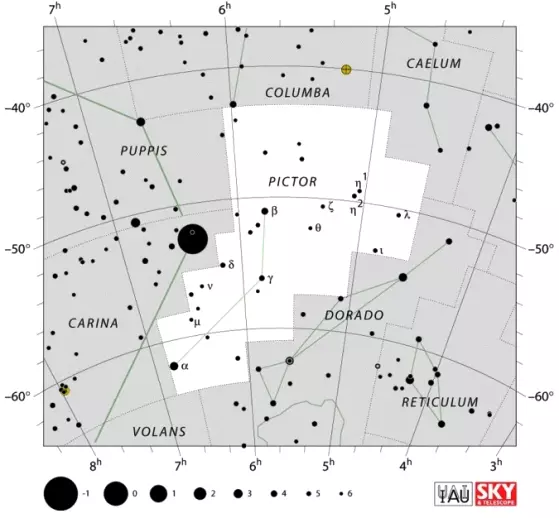
Pictor constellation map by IAU and Sky&Telescope magazine
Story
Pictor constellation is not associated with any myths. It was introduced by Nicolas Louis de Lacaille in 1756 as le Chevalet et la Palette, which means “the easel and palette.” In 1763, he named the constellation Equuleus Pictoris on his planisphere.
The name was shortened to Pictor in 1845 by the English astronomer Francis Baily in his British Association Catalogue on the suggestion of the English astronomer and mathematician John Herschel.
Major stars in Pictor
α Pictoris (Alpha Pictoris)
Alpha Pictoris is the brightest star in the constellation. It is a white main sequence star with the stellar classification of A8 Vn kA6. It has an apparent magnitude of 3.27 and is approximately 97 light years distant from the Sun. The star is bright enough to be seen without binoculars from the southern hemisphere. It is believed to be about 660 million years old.
Alpha Pictoris is a Lambda Boötis type star, which is to say, a peculiar star with a very low abundance of iron peak elements in its surface layers. It is a fast spinner, with a projected rotational velocity of 206 km/s, and it is classified as a rapidly rotating shell star, one that may have ejected mass from its outer atmosphere. The star has 2.04 solar masses, 1.6 times the solar radius, and it is 13 times more luminous than the Sun. It is a known X-ray source, which may suggest that it is in fact a spectroscopic binary system.
Alpha Pictoris is also notable for being the South Pole star on Mercury.
β Pictoris (Beta Pictoris)
Beta Pictoris is the second brightest star in Pictor. It is located just to the west of the bright star Canopus in Carina constellation. It has an apparent magnitude of 3.861 and is approximately 63.4 light years distant from Earth.
It is a white main sequence dwarf with the stellar classification of A6 V. It has a mass between 1.7 and 1.8 times solar and a radius 1.8 times that of the Sun.
The star is classified as a Delta Scuti variable, which means that it exhibits variations in brightness as a result of both radial and non-radial pulsations of its surface.
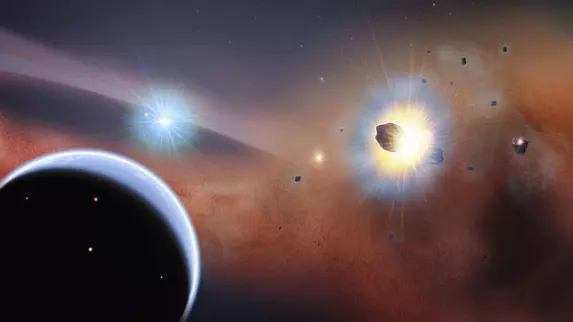
This artist’s concept illustrates the preferred model for explaining ALMA observations of Beta Pictoris. The new observations from ALMA now show that the disc around the star is permeated by carbon monoxide gas. The presence of carbon monoxide could indicate that the Beta Pictoris planetary system may eventually become a good habitat for life. At the outer fringes of the system, the gravitational influence of a hypothetical giant planet (bottom left) captures comets into a dense, massive swarm (right) where frequent collisions occur. Image: NASA’s Goddard Space Flight Center/F. Reddy
The star is believed to have a large dust disk, possibly a protoplanetary disk, in its orbit, and a young gas giant planet within the debris disk. The planet was observed in 2009.
It has a mass about 8 times that of Jupiter. Material from the star’s debris disk is believed to be the main source of meteoroids in our solar system.
Beta Pictoris is the brightest member of the Beta Pictoris Moving Group, a group of young stars that share a common origin and a common motion through space. The Beta Pictoris Moving Group is the closest young stellar association of this kind to Earth. It consists of 17 stellar systems, or 28 individual member stars.
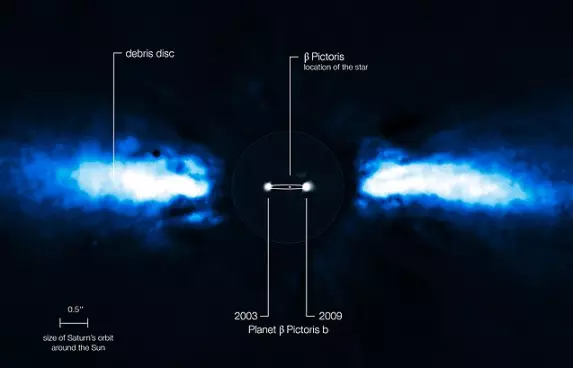
For the first time, astronomers have been able to directly follow the motion of an exoplanet as it moves to the other side of its host star. The planet has the smallest orbit so far of all directly imaged exoplanets, lying as close to its host star as Saturn is to the Sun. The team of astronomers used the NAOS-CONICA instrument (or NACO), mounted on one of the 8.2-metre Unit Telescopes of ESO’s Very Large Telescope (VLT), to study the immediate surroundings of Beta Pictoris in 2003, 2008 and 2009. In 2003 a faint source inside the disc was seen, but it was not possible to exclude the remote possibility that it was a background star. In new images taken in 2008 and spring 2009 the source had disappeared! The most recent observations, taken during autumn 2009, revealed the object on the other side of the disc after having been hidden either behind or in front of the star. This confirmed that the source indeed was an exoplanet and that it was orbiting its host star. It also provided insights into the size of its orbit around the star. The above annotated composite shows the reflected light on the dust disc in the outer part, as observed in 1996 with the ADONIS instrument on ESO’s 3.6-metre telescope. In the central part, the observations obtained in 2003 and autumn 2009 with NACO of the planet are shown. The possible orbit of the planet is also indicated, albeit with the inclination angle exaggerated. Image: ESO/A.-M. Lagrange
γ Pictoris (Gamma Pictoris)
Gamma Pictoris is the third brightest star in the constellation. It has an apparent magnitude of 4.50 and is approximately 174 light years distant from the Sun. The star is an orange giant belonging to the stellar class K1III.
δ Pictoris (Delta Pictoris)
Delta Pictoris has the stellar classification B3III. It has an apparent magnitude of 4.72 and is approximately 1,655 light years distant from the Sun. The star is classified as a Beta Lyrae variable, a close binary star that exhibits variations in luminosity because the two components periodically block each other’s light as they orbit. Delta Pictoris varies from magnitude 4.59 to 4.8 over a period of 40.08 hours.
Kapteyn’s Star
Kapteyn’s Star, first catalogued by the Dutch astronomer Jacobus Kapteyn in 1898, is a red dwarf belonging to the spectral class M1 with an apparent magnitude of 8.853. The star is only 12.76 light years distant from Earth. It can be seen through binoculars or a small telescope.
At the time of discovery, the star had the highest proper motion of any star known, more than 8 seconds of arc per year. After the discovery of Barnard’s Star in Ophiuchus constellation in 1916, Kapteyn’s Star dropped to second place.
About 10,800 years ago, the star came within 7 light years of the solar system and has been moving away since. It is cooler than the Sun and has only 0.274 times the Sun’s mass and 0.291 times the solar radius. It belongs to the stellar class sdM1, which means that the star is a subdwarf, a star that is less luminous than a main sequence star in the same spectral class.
Kapteyn’s Star is classified as a BY Draconis type variable, a star whose brightness varies as a result of magnetic activity in its chromosphere coupled with rotation, and has the variable designation VZ Pictoris.
The star is also notable because it orbits the Milky Way retrograde and is the nearest halo star to the Sun.
AB Pictoris
AB Pictoris is an orange main sequence star belonging to the stellar class K2V. It has an apparent magnitude of 9.16 and is approximately 148 light years distant from the Sun.
The star is a BY Draconis variable, a main sequence variable star that exhibits variations in brightness as a result of rotation coupled with star spots and other chromospheric activity.
An object was observed near the star in 2003 and 2004 that had the same proper motion, which indicated that the two were physically close. It has an estimated mass about 13.5 times that of Jupiter and is either an extrasolar planet or a brown dwarf.
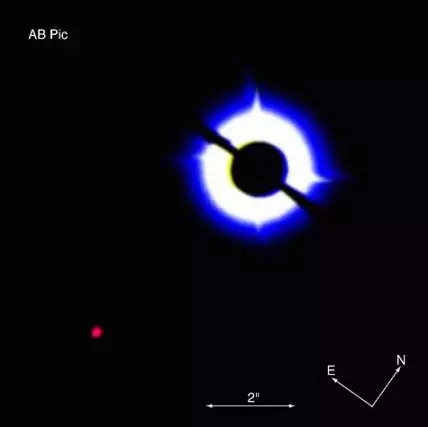
Coronagraphic image of AB Pictoris shows its tiny companion (bottom left). The data was obtained on 16 March 2003 with NACO on the VLT, using a 1.4 arc second occulting mask on top of AB Pictoris. Image: ESO
HD 40307
HD 40307 is an orange main sequence dwarf with the stellar classification of K2.5 V. It has a visual magnitude of 7.17 and is about 41.8 light years distant from Earth. It has a mass 0.75 times that of the Sun and a radius 0.716 times solar.
The star has 6 confirmed planets in its orbit. Three were discovered in 2008 and another three in 2012. One of the planets, HD 40307 g, is a super-Earth, which means that it is more massive than our planet, but not as massive as the smaller gas giants in the solar system (Uranus and Neptune).
The planet lies within the star’s habitable zone and completes an orbit around the star every 200 days.

HD 40307 – Artist’s impression of the trio of super-Earths discovered by an European team using the HARPS spectrograph on ESO’s 3.6-m telescope at La Silla, Chile, after 5 years of monitoring. The three planets, having 4.2, 6.7, and 9.4 times the mass of the Earth, orbit the star HD 40307 with periods of 4.3, 9.6, and 20.4 days, respectively. Image: ESO
HD 41004
HD 41004 is a multiple star system in Pictor. The main component is an orange main sequence dwarf star belonging to the stellar class of K1 V. It has an apparent magnitude of 8.65 and is 138.6 light years distant from the solar system.
A planet was discovered orbiting the star in 2003. It has a mass at least 2.56 times that of Jupiter and orbits the star with a period of 963 days.
The secondary component in the HD 41004 system is a red dwarf of the spectral type M2V. It has a visual magnitude of 12.33 and is 140.35 light years distant. A brown dwarf is orbiting the star with every 1.3283 days.
Deep sky objects in Pictor
NGC 1705
NGC 1705 is a peculiar lenticular galaxy in Pictor. It has a visual magnitude of 12.8 and is approximately 17 million light years distant from Earth.
The galaxy is classified as a Blue Compact Dwarf (BCD) galaxy, which means that it contains large clusters of hot, young, very massive stars which make the galaxy appear blue.
NGC 1705 is a member of the Dorado Group, a loose group of galaxies located primarily in the Dorado constellation.
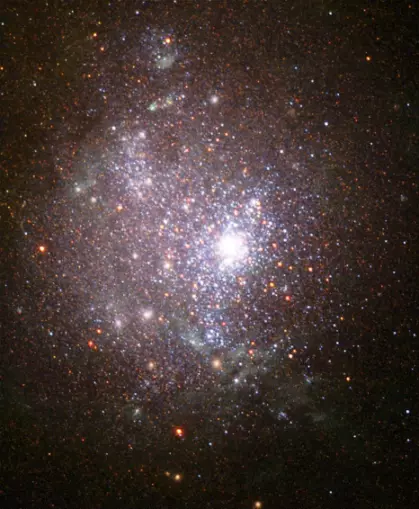
The central region of the small galaxy NGC 1705 blazes with the light of thousands of young and old stars in this image, taken by NASA’s Hubble Space Telescope. Image: NASA, ESA, and The Hubble Heritage Team (STScI/AURA)
Pictor A
Pictor A is a double lobed radio galaxy with a supermassive black hole in its centre. The black hole has a relativistic jet dashing out 800,000 light years to a bright X-ray hot spot located at the western end of the galaxy’s western lobe.
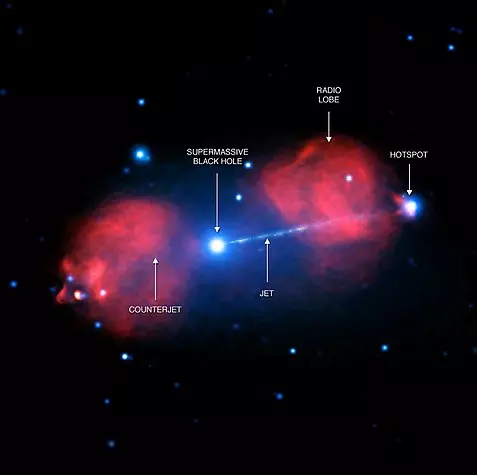
The Pictor A galaxy has a supermassive black hole at its center, and material falling onto the black hole is driving an enormous beam, or jet, of particles at nearly the speed of light into intergalactic space. This composite image contains X-ray data obtained by Chandra at various times over 15 years (blue) and radio data from the Australia Telescope Compact Array (red). Image – X-ray: NASA/CXC/Univ of Hertfordshire/M.Hardcastle et al., radio: CSIRO/ATNF/ATCA
SPT-CL J0546-5345
SPT-CL J0546-5345 is a massive galaxy cluster, one of the most massive clusters discovered in the early universe. It contains hundreds of galaxies. The cluster is believed to lie some 7 billion light years from Earth. It was discovered in 2008. If we could see the cluster as it is today, it would likely be about 4 times larger.
7 billion years ago, at a relatively young age, the cluster was almost as massive as the Coma Cluster in Coma Berenices constellation.